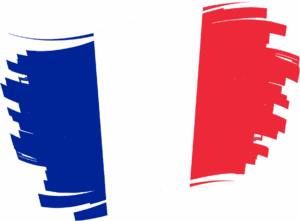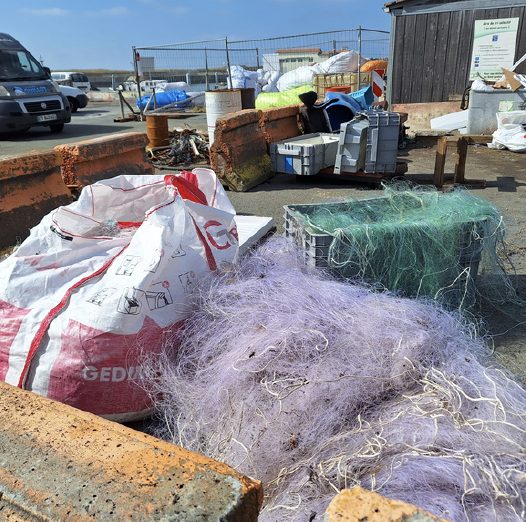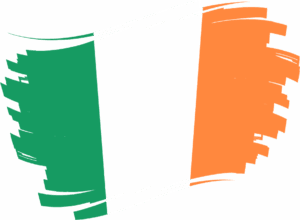
Fishing port of Le Guilvinec
Fishing port, marina & ship repair area Presence of a fish market
Flotilla of 98 vessels (mostly deep-sea)

Fishing port and marina
Presence of a fish market
Flotilla of 95 fishing vessels (trawlers, trollers, pot vessels gillnetter)
![]()
• 6 skips on the docks for EOLFG (nets and ropes)
• Closed port waste collection centre for the management of CIW and hazardous waste.
• Collection and recycling of nets by Fil&Fab to recover the raw material.
• Experiment conducted by Fil&Fab and WWF: recovery of 3 tonnes of trawl nets in May 2024
(shredding and recycling tests).
• FILIPECH project in 2022: 2 tonnes of trawl nets sent to Plastix (Denmark) for recycling.
• Fishermen put their used fishing nets and gear directly into the skips.
• There are 2 social work structures in the port: ‘L’Atelier des gens de mer’ (managing the waste collection centre) and the ESAT ‘Claires et mer’ (dismantling nets).
• Management costs: included in the port user fee.
• All waste costs the port at least €100,000 per year.
• Quantity: 6T of nets in 2024 / 10T of used trawls / year.
![]()
Fishermen bring the passively fished waste back to the port (green bags supplied by ReSeaclon and bins on the quayside). Test operation by ReSeaclons carried out with 4 to 5 boats in order to quantify and qualify the waste passively fished.
Waste passively fished increases the cost of waste paid by the port. Fishermen do not sort waste which is an obstacle to recovery.
![]()
• Constant increase in the cost of waste management.
• Trawls stored on docks awaiting recycling solution.
• Active involvement of the harbour in the management of port waste (waste reception plan dated 2023).
• Closed waste collection centre (to prevent illegal dumping).
• Diagnostic carried out in 2021 to identify ways of improving waste management and raise awareness among port users.
• Long tradition of management and recycling of nylon nets via the presence of 2 disabled employment structures in the port.
• A tripartite agreement between the port, the Atelier des gens de mer and Fil&Fab for the recycling of nets implemented in 2024.
• Objectives:
o Set up a recycling scheme for trawl nets.
o Improve port users’ compliance with waste regulations.
o Increase awareness of waste issues among port users.

Fishing port, marina & ship repair area Presence of a fish market
Flotilla of 98 vessels (mostly deep-sea)

This is a multi-purpose port which accommodates approx.
20 trawlers, 5 scallop boats and 25 inshore vessels for crab, lobster & whelk. In addition, charter deep-sea angling vessels, tourboats to the Saltee Islands, and leisure crafts use the port.
There are also seafood processing plants next to the port.

Fishing port and marina
Presence of a fish market, online sales only Flotilla of 30 vessels (gillnetter and trollers)

Fishing port
A fish market (1st auction in Normandy and 6th in France) Fleet of 61 vessels (mainly trawlers)

Commercial, nautical-sport, tourism, fishing, and shipyard activities, fish market.
Fishing practice: for WIF, three trawlers from the Mares Circulares project (with lengths ranging from 28 to 36 meters) are collaborating
Landings: Atlantic mackerel, European anchovy, and Atlantic bonito

A busy port that is home to several state organisations and fishing businesses. Including a seafood processing plant, an ice plant, fisherman’s co-op, and shipping agents. Cruise liners and island ferries also dock here.
30 x >20m fishing vessels are based at the port, the majority are whitefish trawlers.

Fishing activity and fish market.
Fishing practice: fleet of 144 vessels and ships (mostly small-scale fishing vessels)

Fishing, seafood processing and sales.
Marine leisure cruises, sailing club, tourism.
Fishing practice: There are currently 5 pelagic trawlers, 36 demersal trawlers and 12 crabbers.
Landings: Prawn, Crab and white fish

Fishing port, commercial port and marina Presence of a fish market
Flotilla of 40 fishing vessels (mainly coastal fishing) 1500 deep-sea trawlers landing fish every year.